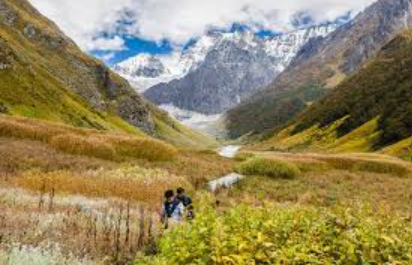Introduction
Mountain Valleys NYT, often regarded as some of the most breathtaking natural landscapes on Earth, play a significant role in the environment, ecology, and even human civilization. The stunning valleys found in the heart of mountain ranges provide more than just scenic views; they are home to diverse ecosystems, unique climates, and offer resources that support both nature and people. From their geological formation to their current importance in tourism and environmental conservation, mountain valleys nyt are truly remarkable natural features. In this article, we will explore various aspects of mountain valleys nyt and delve into why they continue to captivate both travelers and scientists alike.
What is a Mountain Valley?
A mountain valley is a low area between mountains, often formed by the erosion of rivers or glaciers. These valleys can vary in size and shape, typically taking on a U-shaped or V-shaped profile, depending on the forces that shaped them. Valleys are generally categorized into two types:
- Glacial Valleys: Carved by the slow movement of glaciers, these valleys usually have a U-shape and can be seen in regions that have experienced significant glaciation.
- River Valleys: Created by the continuous flow of water eroding the land over time, these valleys often have a more defined V-shape.
The Formation of Mountain Valleys NYT
Mountain valleys nyt are typically formed through processes of erosion. Over time, rivers and glaciers carve their way through rock and soil, creating deep grooves in the landscape. In glacial valleys, large masses of ice move slowly over the earth, scraping away rocks and soil to create a wide, flat bottom. As glaciers retreat, these valleys are often filled with lakes or rivers, adding to their beauty. River valleys, on the other hand, are created by the flowing water from rivers that slowly wear away the earth, leaving behind a narrow, steep-sided valley.
Glacial Valleys
Glacial valleys, with their characteristic U-shaped cross-sections, are typically found in colder climates where glaciers once dominated. The massive glaciers, during their movements, eroded the underlying rock surfaces, resulting in broad and deep valleys. Some of the world’s most famous valleys, such as Yosemite Valley in the United States, were shaped by this process.
River Valleys
River valleys, on the other hand, are more common in warmer climates or areas without significant glaciation. These valleys, with their V-shaped profiles, are formed by the relentless flow of water over millions of years. Famous examples include the Colorado River’s Grand Canyon, where the river has carved out one of the most spectacular valleys in the world.
The Ecological Importance of Mountain Valleys NYT
Mountain valleys nyt are not just visually stunning; they are also critical to the health of the environment. These valleys often serve as habitats for a wide variety of plant and animal species. Because of the varying altitudes and climates, mountain valleys nyt often host unique ecosystems that cannot be found elsewhere.
Biodiversity Hotspots
Mountain valleys nyt often support diverse ecosystems, with many species of plants and animals that are adapted to the particular climate and conditions found there. For example, valleys in the Himalayas support species like the snow leopard, Himalayan tahr, and a variety of medicinal plants that grow only in that region.
Water Sources and Agriculture
Valleys are also crucial water sources. Many rivers that flow through mountain valleys nyt provide water to lower-lying areas, supporting agriculture and human settlements. The rich soils deposited by rivers make these areas fertile for farming, making valleys some of the most important agricultural regions in the world.
Human Interaction with Mountain Valleys NYT
Mountain valleys nyt have long been home to human populations, offering resources such as water, fertile land, and natural protection. These valleys are often home to vibrant communities and have historically been used for farming, trade routes, and as settlements. Today, many mountain valleys nyt are important tourism destinations, with travelers flocking to these areas for hiking, skiing, and sightseeing.
Tourism and Economic Impact
Tourism has become one of the largest industries in mountain valleys nyt, especially in areas like the Swiss Alps, the Rockies, and the Himalayas. The stunning scenery, combined with recreational opportunities such as hiking, skiing, and mountaineering, make these valleys popular destinations for both adventure seekers and nature lovers. The influx of tourists provides a significant boost to local economies, creating jobs and supporting businesses that cater to visitors.
Preserving Mountain Valleys
While mountain valleys are valuable for their beauty, ecology, and resources, they are also vulnerable to environmental changes and human activity. Climate change, deforestation, and over-tourism threaten the delicate ecosystems that exist in these valleys. It is essential to take steps to preserve these natural wonders for future generations.
Conservation Efforts
Many governments and organizations are working to protect mountain valleys through conservation efforts. National parks, protected areas, and eco-tourism initiatives are designed to balance human use with the need to preserve the environment. Public awareness campaigns also play a critical role in educating people about the importance of protecting these ecosystems.
Conclusion
Mountain valleys, with their stunning beauty and ecological significance, are some of the most vital natural features on Earth. From their formation through glaciers and rivers to their role in biodiversity, water resources, and human activities, these valleys are essential to both nature and humanity. However, they face significant threats from climate change and human development, making conservation efforts more important than ever. By understanding their value and taking steps to protect them, we can ensure that mountain valleys nyt continue to thrive for generations to come.
FAQs
Q1: What is the primary difference between a glacial valley and a river valley?
A: A glacial valley is typically U-shaped and formed by glaciers, while a river valley is V-shaped and formed by the erosion of flowing water.
Q2: Why are mountain valleys important for biodiversity?
A: Mountain valleys support unique ecosystems with species that are often adapted to specific altitudes and climates, making them important biodiversity hotspots.
Q3: How are mountain valleys nyt used by humans?
A: Mountain valleys have been used for agriculture, settlements, trade routes, and are now popular tourism destinations.
Q4: What are some famous mountain valleys?
A: Famous examples include Yosemite Valley, the Grand Canyon, and valleys in the Swiss Alps and the Himalayas.
Q5: What threats do mountain valleys face?
A: The biggest threats to mountain valleys include climate change, deforestation, and over-tourism, which can disrupt delicate ecosystems.




